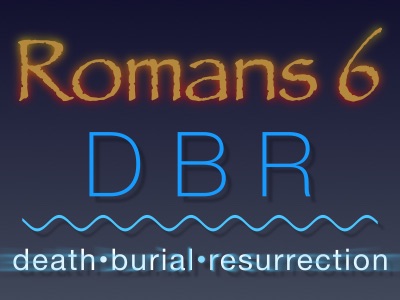
Here is the first scripture we use to argue that water baptism is necessary for salvation. It’s Romans 6:1-11. This is a long passage holding wonderful treasures, the first of which harkens back to our lesson about the correct method of baptism. Let’s listen to it.
Romans 6:1-11
“What shall we say, then? Shall we go on sinning so that grace may increase? By no means! We died to sin; how can we live in it any longer?Or don’t you know that all of us who were baptized into Christ Jesus were baptized into his death?
We were therefore buried with him through baptism into death in order that, just as Christ was raised from the dead through the glory of the Father, we too may live a new life.
If we have been united with him like this in his death, we will certainly also be united with him in his resurrection. For we know that our old self was crucified with him so that the body of sin might be done away with, that we should no longer be slaves to sin–because anyone who has died has been freed from sin.
Now if we died with Christ, we believe that we will also live with him. For we know that since Christ was raised from the dead, he cannot die again; death no longer has mastery over him. The death he died, he died to sin once for all; but the life he lives, he lives to God.
In the same way, count yourselves dead to sin but alive to God in Christ Jesus.”
Romans 6 – Verse by Verse
Wow. What a rich passage of scripture. Let’s dissect this verse by verse.
Verse 1-2
“What shall we say, then? Shall we go on sinning so that grace may increase? By no means! We died to sin; how can we live in it any longer?”
The first part of this verse addresses a misunderstanding in the early church where some people thought that if they sinned more, God’s grace was revealed even more. Paul says, in effect, “That dog don’t hunt so stop thinking that way.”
But notice something. Paul is addressing people who are already saved. How do we know this? Because all of it is in the past tense. He identifies them as people who have (past tense) “died to sin.” If someone has “died to sin” that means that their sins have been forgiven and they are no longer living a life of sin. These are people who have died and been raised again to their new life in Christ. They have been Born Again. Let’s dig a little deeper and ask the critical questions: “When did this happen and where did it happen.” Paul answers these questions in verse three.
“Or don’t you know that all of us who were baptized into Christ Jesus were baptized into his death?”
Baptized into His Death
In this sentence, Paul tells us this “death to sin” occurred when these people were baptized into Christ. He tells us they were “baptized into his death.” Ah… two critical truths! First, we get “into” Christ through something called “baptism.” Second, we learn this “baptism” places us “into Christ’s death.” These are important truths to understand.
There is no other way, in all of scripture to get “into” Christ or “into his death.” And to be clear… these are not symbolic things. These are, what I like to call, “reality things;” things which are really happening. At the time of baptism, we are put into Christ and into his death by the Holy Spirit. But the process does not stop there. We are not left dead and buried, just as Christ was not left dead and buried.
Verse 4
“We were therefore buried with him through baptism into death in order that, just as Christ was raised from the dead through the glory of the Father, we too may live a new life.”
Buried with Him
There is a lot here! This verse begins with the word, “therefore.” In my early years as a disciple, I was taught that whenever you see the word “therefore” in a scripture, you should always back up a few verses and find out what it is there for! If we do that, we must read verse four in light of verses 1-3.
These people had died with Christ in baptism, been baptized into his death and baptized into Christ himself. “Therefore…” they were buried with Christ, how? Through baptism. So, by this thing Paul calls “baptism,” a person is buried with Christ. But, into what? Into death. Why? For what purpose? In order that “just as Christ was raised from the dead…” they too could be raised to a new life as well.
Now, let’s flip things on their heads and ask some inverse questions. What happens if I am not baptized into Christ? If I am not baptized, can I get “into his death?” If I am not buried with him through baptism, will I be raised with him? If I am not raised with him in baptism can I be ushered into a new life just like Christ was ushered into new life?
On the surface, it might seem like the answer to these questions is, “No!” But, I don’t think that would be dealing honestly with the scripture.
Don’t go gettin’ all dogmatic!
The honest answer to these questions is not “No!” The honest answer is, “I don’t know.” That’s the truth. Let me explain. There is a temptation to say, “If I am NOT baptized I can NOT be in Christ,” but the scriptures do not make that negative claim, do they? They simply state the positive. That’s the truth. I think this is one way a pro-baptism proponent shoots himself in the foot. All to often a pro-baptism proponent can be pretty dogmatic about this erroneous position. The scripture does not say, “If you are NOT baptized you will not be with Christ.”
However, the initial statement is so clear and so direct it would not make sense to consider any other course of action if I wanted to be raised with Christ. So, while the honest answer to the inverse question is not “No,” Rejecting the instruction leaves a vast chasm of doubt and insecurity, especially when we consider what comes next.
Romans 6:5
“If we have been united with him like this in his death, we will certainly also be united with him in his resurrection.”
This is a conditional and it is a huge conditional. The claim begins with “if.” “If we have been united with him like this in his death.” How are we “united with him like this in his death?” By participating in baptism. Is this a metaphor for something? No. This is what happens in baptism. We are “united with him in his death!” What happens next? “We, will certainty be united with him in his resurrection.” That’s awesome!
What happens if I am NOT united with him in his death? Do I have any assurance that I will be united with him in his resurrection? No, no promises. The only confidence I can have is “if” I am united with him in his death. Once again, don’t build a false assumption in the absence of the negative, the truth of the positive stands powerfully alone.
I love these conditionals because they kind-of box us in. They don’t leave much wiggle room. Things get tightened down… especially when we ask that inverse question begged by the “if” statement.
Lets’ move on to verse 6 and 7.
“For we know that our old self was crucified with him so that the body of sin might be done away with, that we should no longer be slaves to sin–because anyone who has died has been freed from sin.”
Let’s start at the bottom and work our way up.
How not to sin.
I have a sure-fire way to help us in our quest to never commit another sin. Wouldn’t that be great? Wouldn’t it be awesome if we never sinned again? Here’s all we need to do and I guarantee it will work, 100% of the time…. All we need to do is die! This is what this scripture tells us. In baptism, we die and we are therefore free from sin! The Bible uses this imagery a number of times describing Christians as people who have died to their old life. It’s quite a picture.
So, in verse 6 and 7 we learn that baptism is where we die to sin. If we have not died, are we free from sin? It does not say that, but the safe bet would be, “No.” If we have not died, sin is still our master! How did we die? Our old self was “crucified with him.” How is that possible, we were not at the cross? “Our old self was crucified,” in baptism. That’s the subject of these passages. Why are we crucified with Christ? “So that the body of sin might be done away with.” What does that mean? It means we are done with sin. It means our sins were wiped away. They are no longer a part of us. We will no longer be slaves to sin because we are dead.
Can you think of any other place in all of scripture where we are taught that sins are rendered powerless by some other means or at some other time in the conversion process outside of baptism? I can’t.
Romans 6:8
“Now if we died with Christ, we believe that we will also live with him.”
Once again, we see that conditional. The word “if” is used to establish a clear fork in the road. If I die with Christ… where does that happen? In baptism. If I died with Christ I believe I will live with him. What if I do not die with Christ? Do I have any confidence at all that I will live with him? No, I am on shaky ground. I am not promised anything. Do I honestly want to be on that road? Why not just obey the command and accept the guarantee?
Next we find a bit of a set-up for what Paul is about to say.
Romans 6:9-10
“For we know that since Christ was raised from the dead, he cannot die again; death no longer has mastery over him. The death he died, he died to sin once for all; but the life he lives, he lives to God.”
This speaks about Christ’s resurrection. He is raised from the dead. Death only gets to do its work once. After that, death can not have control over Christ. Christ died to sin one time and for all people. The resurrected life he lives, he lives to God. Now that Paul has that teed up, let’s see what he does with it.
Verse 11
In the same way, count yourselves dead to sin but alive to God in Christ Jesus.
In the same way as what? In the same way as Christ! Do what? Count yourself dead to sin and alive to God, in Christ. Oh! So, now we are “in Christ.” When did that happen? It had to have happened sometime between death and resurrection! Where does that happen for a believer? In baptism.
A Quick Plunge into a Rabbit Hole
Let’s take a quick detour just for fun….
In Romans 6 we learn that we are crucified with Christ and we die! It does not say this is symbolic or a metaphor for anything. It also said, “we were baptized into death!”
This is a great mystery and something which is probably worthy of a lot deeper study. Do people actually die in baptism? Whatever this thing called “death” actually is, is that what happens to us in baptism? Do we actually experience this thing called “death” so that we will never experience it again? Death no longer has mastery over someone who has died, right? It only gets to do it’s job one time. Yeah this is a bit of a rabbit hole but some time we should study this one out. Very interesting.
Romans 6 offers an amazing look at the complete Born Again experience. When we submit ourselves to bible baptism, we are participating in the death, the burial and resurrection of Jesus Christ. Nowhere in all of scripture do we find such a clear explanation of what happens in baptism. When we allow ourselves to be baptized, we die, we are buried and we are resurrected with Christ.
Romans 6 is not about water baptism!
Now, I know the critics are chomping at the bit. They claim, “Romans 6 is not about water baptism.” They claim, with great confidence, this is a spiritual baptism. There are two problems with this conclusion. The first problem is the issue posed by Ephesians 4:5, there is only one baptism.
In previous studies we discovered there is indeed only one baptism but two things are happening. Let me refer you to A Faith that Obeys Podcast “029 – Multiple Baptisms,” for a complete study of that issue.
Second, when I ask my evangelical friend if their church baptizes by complete immersion and they say, “Yes.” My next question is, “What scripture would you use to prove that water baptism should be done by immersion and not a sprinkling or pouring?” They quickly point to Romans 6. Hopefully you see the problem. We can’t claim Romans 6 is exclusively a spiritual baptism then use Romans 6 and claim it is a water baptism too.
This scripture is pretty much to go-to scripture for anyone who wants to explain why their church practices full immersion baptisms instead of sprinkling or pouring. The reason it serves this function so nicely is because it graphically depicts baptism as a death, burial and resurrection as a person is lowered into water, held there briefly, then raised out of the water.
When we accept Paul’s Ephesians assertion, “there is only one baptism” and we understand that two things are happening in that one baptism, we understand how Romans 6 can be a baptism in water and a spiritual baptism at the same time. It’s very easy.
Baptism – A Participation in the Death, Burial and Resurrection of Christ!
In the process of water baptism, a person is lowered into water, completely immersed or buried and raised again out of the water. In this process, we see something very symbolic happen. We see a death, a burial and a resurrection. While water baptism contains amazing symbolism, baptism itself is not a symbol of anything.
Baptism is, as I’ve stated, a participation in the death, burial and resurrection of Jesus Christ. Baptism is an act of direct obedience to the Great Commission and the Gospel of Christ. Baptism is where and when a sinner is born again.
Romans 6 is clearly about baptism, the one baptism which is done in water by the Holy Spirit which places a person into the Kingdom of God by allowing them to be crucified with Christ, buried and resurrected. Baptism is how we execute and obey the Great Commission. Baptism is how we obey the Gospel. Our baptism is a response which only comes from A Faith that Obeys.
Enjoy!Dana Haynes

